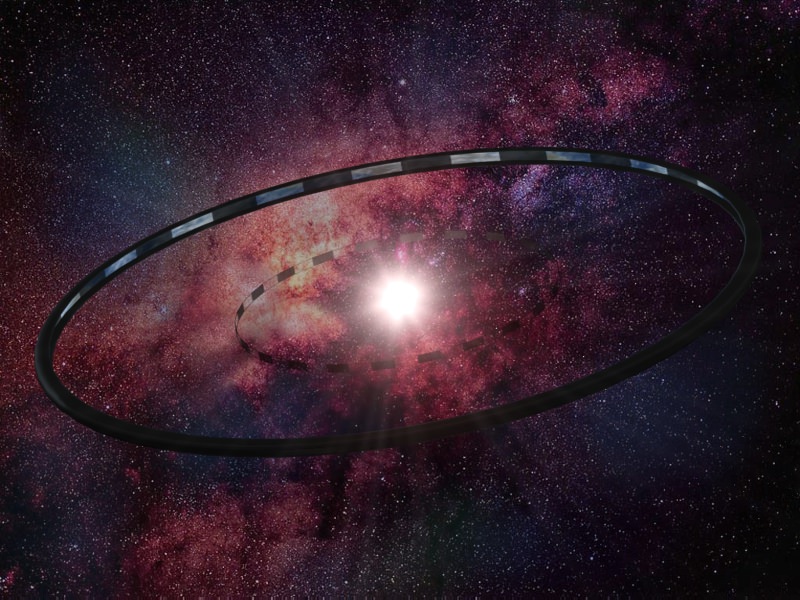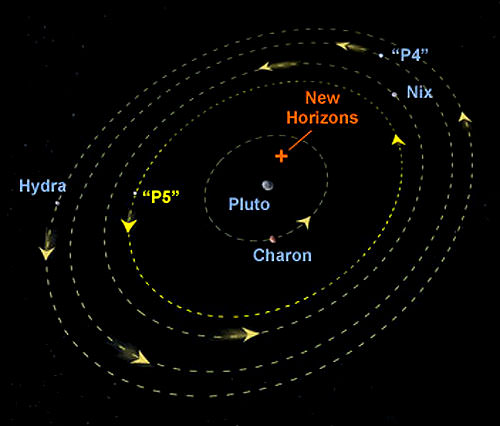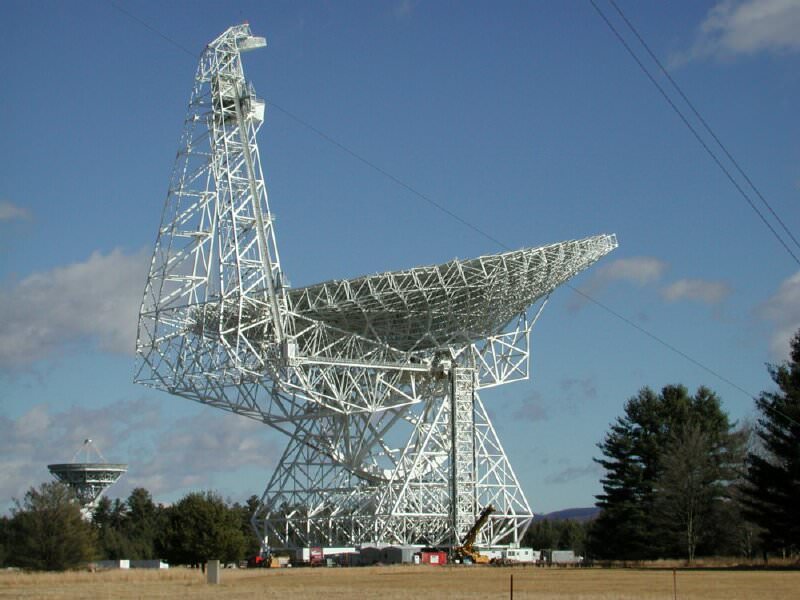It’s a big galaxy out there. Even the most skeptical scientist has to accept that if a civilisation like our own exists, then there’s a good chance we’re not the only one to have ever done so. When most people think about SETI (the search for extraterrestrial intellgence), they imagine someone like Ellie Arroway searching the skies for radio transmissions. But what about looking in other ways? Perhaps a highly advanced alien civilisation might build structures large enough for us to see.
Continue reading “Hunting for Alien Megastructures”
Pluto May Soon Have a Moon Named Vulcan (Thanks to William Shatner)
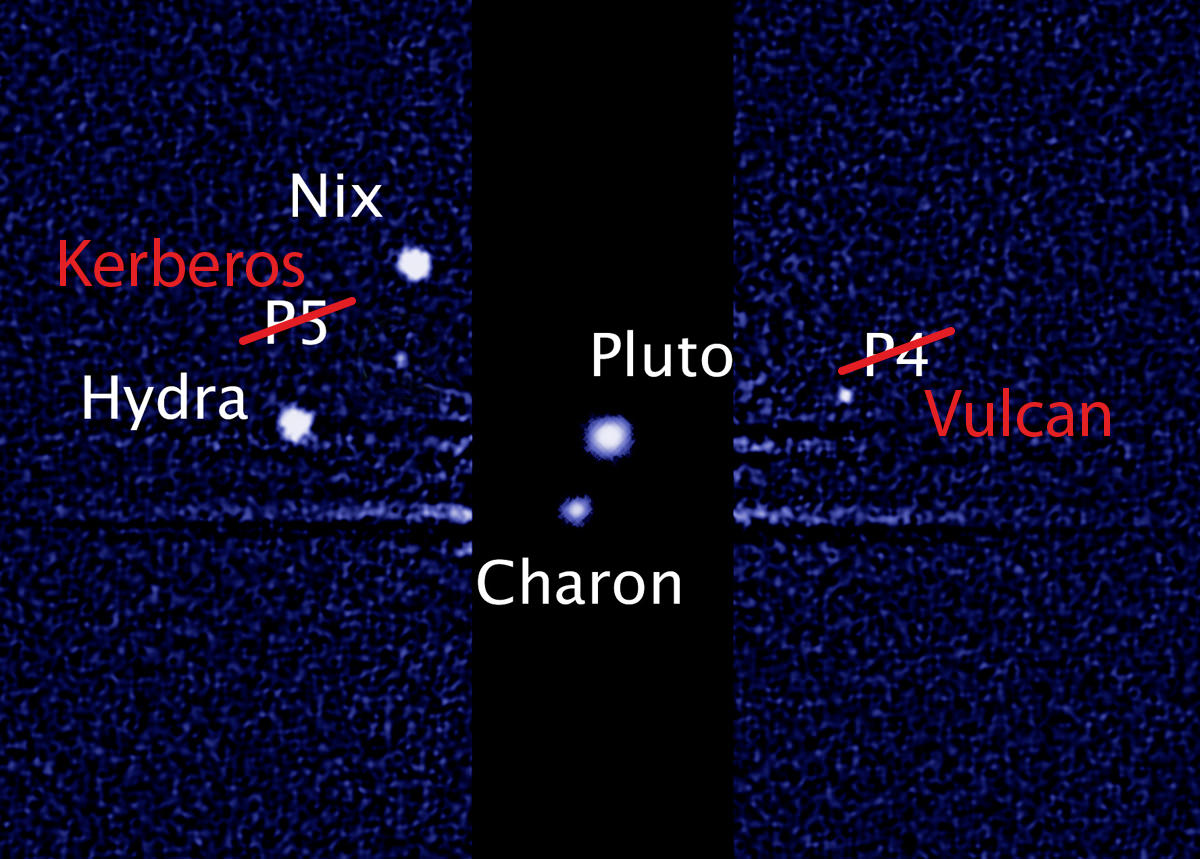
The votes have been tallied and the results are in from the SETI Institute’s Pluto Rocks Poll: “Vulcan” and “Cerberus” have come out on top for names for Pluto’s most recently-discovered moons, P4 and P5.
After 450,324 votes cast over the past two weeks, Vulcan is the clear winner with a landslide 174,062 votes… due in no small part to a little Twitter intervention by Mr. William Shatner, I’m sure.
In other words… yes, the Trekkies have won.
 During a Google+ Hangout today, SETI Institute senior scientist Mark Showalter — who discovered the moons and opened up the poll — talked with SETI astronomer Franck Marchis and MSNBC’s Alan Boyle about the voting results. Showalter admitted that he wasn’t quite sure how well the whole internet poll thing would work out, but he’s pleased with the results.
During a Google+ Hangout today, SETI Institute senior scientist Mark Showalter — who discovered the moons and opened up the poll — talked with SETI astronomer Franck Marchis and MSNBC’s Alan Boyle about the voting results. Showalter admitted that he wasn’t quite sure how well the whole internet poll thing would work out, but he’s pleased with the results.
“I had no idea what to expect,” said Showalter. “As we all know the internet can be an unruly place… but by and large this process has gone very smoothly. I feel the results are fair.”
As far as having a name from the Star Trek universe be used for an actual astronomical object?
“Vulcan works,” Showalter said. “He’s got a family tie to the whole story. Pluto and Zeus were brothers, and Vulcan is a son of Pluto.”
And what can you say when even Mr. Spock agrees?
The other winning name, Cerberus, is currently used for an asteroid. So because the IAU typically tries to avoid confusion with two objects sharing the same exact name, Showalter said he will use the Greek version of the spelling: Kerberos.
Cerberus (or Kerberos) is the name of the giant three-headed dog that guards the gates to the underworld in Greek mythology.
Now that the international public has spoken, the next step will be to submit these names to the International Astronomical Union for official approval, a process that could take 1–2 months.
(Although who knows… maybe Bill can help move that process along as well?)
Read more about the names on the Pluto Rocks ballot here, and watch the full recorded Google+ Hangout below:
Naming Pluto’s Moons: Will it Come Down to Trekkies Versus the IAU?
As reported here on Universe Today last week, the SETI Institute has invited the public to vote on the names of Pluto’s 4th and 5th moons. Discovered in 2011 and 2012 respectively, researcher and co-discoverer Mark Showalter will take these names before the International Astronomical Union (IAU) after voting closes on February 25th, 2013.
But days after the polling opened, a curious twist in the tale occurred that Star Trek’s Mr. Spock would only describe as “Fascinating.”
William Shatner, James T. Kirk himself, proposed the name Vulcan for one of Pluto’s unnamed moons. Fans and Trekkies worldwide rallied, and as of writing this, Vulcan enjoys a comfortable lead over Cerberus and Styx which are vying for the 2nd place position.
This astronomical horse-race has the propensity to get interesting. In order to be considered, the IAU’s naming convention simply states “Those that share Pluto’s orbital rhythm take the name of underworld deities,” And the named moons of Charon, Nix & Hydra all follow this convention. Shatner’s case for Vulcan does cite the god as “The nephew of Pluto” in Roman mythology, but anyone who had studied Roman and Greek mythos knows that familial relations can be proven between nearly any given god and/or goddess.
Interestingly, Showalter turned down Shatner’s second Star Trek/mythological suggestion of Romulus, citing that Romulus and Remus are already the names of the moons of asteroid 87 Silvia. While the “double naming” of objects in the solar system isn’t unheard of, it may be a definite strike against a proposal. Cerberus, Orpheus, Hypnos & Persephone are all names in the running that are all also assigned to asteroids.
On February 14th, researchers “Opened up the Gates of Hell” a bit further and took more mythological nominations into the running, adding Elysium, Hecate, Melinoe, Orthrus, Sisyphus, Tantalus, Tartarus and Thantos into the fray. You can write-in candidates such as “Donald,” & “Goofy,” but these stand a proverbial snowball’s chance in Hades of being accepted. Perhaps the backing of a starship captain would help, if Adama or Han Solo were available for hire…
Still, one wonders if the name Vulcan will make it past the gate-keepers at the IAU. The IAU has sparked controversy surrounding Pluto before, in its 2006 decision that angered 5th graders everywhere when they demoted Pluto to dwarf planet status. No solar system body currently holds the name of Vulcan, although one hypothetical one once did; the tiny fleeting world that was once thought to be interior to Mercury’s orbit. Several astronomers even claimed to witness transits of the fleeting world across the face of the Sun, and up until the late 19th century, you could still find Vulcan in many astronomy texts. While the idea of Vulcan as a planet interior to Mercury is out (think of how many telescopes, both amateur and professional, now continuously monitor the Sun daily) it’s not out of the question that a small group of asteroids less than 10 kilometres in size tentatively dubbed “Vulcanoids” may still inhabit the space interior to Mercury.

But if nothing else, the poll is a fun exercise to watch as astronomy fans worldwide delve into mythological lore and dig out the names of obscure gods and goddesses. A similar debate on mythological merits swirled around the naming of the moon of dwarf planet Orcus, ultimately named Vanth in 2009.
While only two names will be selected for P4 & P5, the other denizens of the underworld may just get their day in July 2015 when NASA’s New Horizons spacecraft gives us the first close up look at Pluto and friends. Previous “first flybys” of other planets and asteroids have turned up new moons before, and Pluto may be no different.
“The discovery of so many small moons indirectly tells us that there must be lots of small particles lurking unseen in the Pluto system,” stated Harold Weaver of the Johns Hopkins University of Applied Physics Laboratory. Such debris will be a definite concern as scientists seek to thread the spacecraft’s trajectory past Pluto and its moons.

Discovered 83 years ago to the day on February 18th, 1930 by American astronomer Clyde Tombaugh, Pluto remains an uncharted corner of the solar system. Mr. Tombaugh passed away on January 17th, 1997, and an ounce of his ashes are aboard the New Horizons spacecraft which, along with the Pioneer 10 & 11 and Voyager 1 & 2 spacecraft, are escaping the solar system to wander along the galactic plane.
I’ve also got a proposal out in the running. By naming one of Pluto’s moons Alecto, we would honor Clyde with the inclusion of his initials “CT” on a moon. There is precedent for such a clever tribute before; James Christy honored his wife Charlene in the naming of Pluto’s large moon Charon and Mike Brown paid homage to his wife Diane by naming Eris’s moon Dysnomia.
Whatever happens, it’ll be interesting to see what transpires in the final names of P4/P5 are selected. Hopefully it won’t end in a showdown pitting Trekkies against the IAU… but don’t forget, the Trekkies did keep a television series on the air and got a space shuttle re-named!
Less Than 1% of Exoplanet Systems Have Intelligent Life, Researchers Say
Recent findings say that Earth-like exoplanets could be all around us in our cosmic neighborhood. But how many would be home to intelligent life?
A new study estimates that fewer than 1% of transiting exoplanet systems host civilizations technologically advanced enough to send out radio transmissions that could be detected by our current SETI searches.
That equates to less than one in a million stars in the Milky Way Galaxy that would have intelligent life we could possibly communicate with. But even with those odds, there could be millions of advanced ET’s in the galaxy that we could phone, researchers say.
A group of astronomers, including Jill Tarter from the SETI Institute and scientists at the University of California, Berkeley used the Green Bank Telescope in West Virginia to look for intelligent radio signals from planets around 86 of stars where the Kepler mission has found transiting exoplanets. These specific targets were chosen because they had exoplanets in the habitable zone around the star and there were either five or more exoplanets in the system, or there was super-Earths with relatively long orbits.
The search came up empty in detecting any signals.
“We didn’t find ET, but we were able to use this statistical sample to, for the first time, put rather explicit limits on the presence of intelligent civilizations transmitting in the radio band where we searched,” said Andrew Siemion from UC Berkeley.
The team looked for signals in the 1-2 GHz range which is the region we use here on Earth for our cell phones and television transmissions. Narrowing it down, the team looked for signals that cover no more than 5Hz of the spectrum since there is no known natural mechanism for producing such narrow band signals.
“Emission no more than a few Hz in spectral width is, as far as we know, an unmistakable indicator of engineering by an intelligent civilization,” the team said in their paper.
The telescope spent 12 hours collecting five minutes of radio emissions from each star. Most of the stars were more than 1,000 light-years away, so only signals intentionally aimed in our direction would have been detected. The scientists say that in the future, more sensitive radio telescopes, such as the Square Kilometer Array, should be able to detect much weaker radiation, perhaps even unintentional leakage radiation, from civilizations like our own.
The researchers said these results allows them to put limits on the likelihood of Kardashev Type II civilizations. The Karashev scale is a method of measuring a civilization’s level of technological advancement, based on the amount of energy a civilization is able to utilize. The team said that finding no signals implies that the number of these civilizations that are “noisy” in the 1-2GHz range must less than one in a million per sun-like star.
The team plans more observations with the Green Bank Telescope, focusing on multi-planet systems in which two of the planets occasionally align relative to Earth, potentially allowing them to eavesdrop on communications between the planets.
“This work illustrates the power of leveraging our latest understanding of exoplanets in SETI searches,” said UC Berkeley physicist Dan Werthimer, who heads the world’s longest running SETI project at the Arecibo Telescope in Puerto Rico. “We no longer have to guess about whether we are targeting Earth-like environments, we know it with certainty.”
Sources: UC Berkeley, MIT Technology Review
The Cost of Exploring Space: Film vs. Reality
We all know that space exploration, while certainly not the largest expenditure of most countries, doesn’t come cheap. But neither do big-budget science fiction films, either. Special effects, sets, special effects, popular acting talent… special effects… those all come with hefty price tags that make sci-fi and fantasy films costly ventures — although bigger definitely isn’t always better. If you were to compare the price of real space exploration missions (which provide actual information) to the costs of movies about space exploration (which provide “only” entertainment) what would you expect to find?
This infographic does just that:
“Prometheus’ movie budget would be enough to keep the search for real aliens going for another 52 years.”
Wow. (Maybe they should have just written a check to SETI.)
Infographic provided by Neo Mammalian Studios and paydayloan.co.uk. U.S.S. Enterprise © CBS Studios Inc. All Rights Reserved.
SETI: The Search Goes On
In this new video, SETI founder Frank Drake and astronomer Jill Tarter about why the search of the cosmos is important and needed. Visit SETI online to learn more about the search for signals of extraterrestrial life using radio telescopes on Earth and how you can help.
SETI Astronomer Jill Tarter Recalls ‘Contact,’ 15 Years On
In 1985, famed astronomer, author and TV host Carl Sagan invited Jill Tarter to dinner at his house near Cornell University. Tarter, heavily involved with the Search for Extra-Terrestrial Intelligence, gladly accepted the chance to speak with Sagan, a member of SETI’s board of trustees.
Seated with Sagan and his wife, Ann Druyan, Tarter learned that Sagan had a fiction book on the go.
“Annie said, ‘You may recognize someone in the book, but I think you’ll like her,'” Tarter recalled in an interview with Universe Today.
Suspecting the character was based on herself, Tarter’s response to Druyan was: “‘Just make sure she doesn’t eat ice cones so much.’ It was something I was teased about.”
Female, in a male-dominated field
It was 15 years ago this month that the movie Contact, based on Sagan’s book of the same title, expanded to a run in international theatres after a successful summer in North America. The movie explores the implication of aliens making contact with Earth, but does it from more of a scientific perspective than most films.
While Contact, the movie did not talk about the pi sequences or advanced mathematical discussions in Contact, the book, it did bring concepts such as prime numbers, interference with radio telescopes, and the religion vs. science debate to theatres in 1997.
Tarter, who has just retired as the long-time director of the SETI Institute, said she was stunned by the parallels between her own life and that of Ellie Arroway, the character based on her in Contact. Both lost parents at an early age. Both also had to make their way in a field aggressively dominated by males.
Tarter recalls a meeting with fellow female scientists of her generation some years ago.
“A huge percentage of us had been, in high school, either cheerleaders or drum majorettes. This is so counterintuitive, right? Because we’re the nerds, we’re the brainy ones … (it was because) we were all competitors, and there weren’t any (female) sports to compete at. These sports were open, and we competed, and we generally won.”
Working on set
Tarter cautions the parallels did not totally match. The hopes and aspirations of Ellie in the book, and also the movie, were products of Sagan’s imagination. But the producers and actors of the film did want to get a close sense of what it was like to work with SETI.
After Jodie Foster was cast as Ellie, there were multiple phone calls between the actress and Tarter to discuss SETI.
“From her point of view, she was clear she wasn’t going to teach anyone astronomy. She was interested, in a personal way, about what the scientists were like,” Tarter said.
When the crew was filming at the Arecibo Observatory in Puerto Rico, Tarter flew there to observe the work, meet with Foster and also show the actress around. Tarter recalls bringing Foster up in a cabin that had a perfect view of the telescope, some 500 feet above the dish.
Microphones and walkie-talkies
Filming was an interesting process for Tarter, as well. There were the microphones, and the tools the crew used to check continuity. Most amusingly for Tarter, she observed Foster (reported height 5 feet, 2 inches) needing to stand on a box for most of the close-up shots with actor Matthew McConaughey (reported as 6 feet tall).
Two errors still irk Tarter today. There is a scene when Ellie gives a modified version of the Drake Equation, which calculates the odds of intelligent life who are capable of communicating with other life forms, and the calculations are all wrong. “It’s really infuriating,” Tarter said.
The other large mistake is a scene where Ellie gets a potential signal from space, while working at the Karl G. Jansky Very Large Array set of radio telescopes in New Mexico.
“She’s sitting in the middle of the array, in a car, with her laptop, and she gets the signal. And the first thing she does is pick up a walkie-talkie and start broadcasting. That signal is going to wipe out the signal from the sky. You don’t transmit by walkie-talkie.”
But overall, Tarter said the movie did a great job at portraying the feel of SETI. And Foster appreciated Tarter’s help. “She would write me handwritten thank-you notes, which was a kind of manner that most people have lost. A great courtesy.”
Hollywood outreach
Tarter walked the red carpet at the movie premiere and spent most of her time watching the film in tears of happiness. That euphoria evaporated when she saw the SETI Institute was not credited at the end of the film. When she talked to one of the film producers, she said she was informed that lawyers usually draft agreements specifying the length of time the credit appears, and the compensation received for doing so.
“We don’t have a lawyer at the SETI Institute,” she said. “When I write a paper, I acknowledge my collaborators. We got that wrong, so we never got any credit. We might have gotten even more recognition.”
But the professional connection with Foster still remains. Foster happily responded to a request from Tarter to do voice-overs for a video clip used for a SETI high school curriculum for integrated science. She also narrated a show, Life: A Cosmic Story, for the California Academy of Sciences Morrison Planetarium.
Tarter is now shifting into full-time outreach for SETI, saying the budgetary problems that shut down the organization’s Allen Telescope Array for several months last year were a warning call.
One of the organization’s newest initiatives is SETILive.org, which crowdsources analysis of signals from the Kepler Field. SETI solicits the public to take some time looking at the signal patterns, one at a time, in search of extraterrestrial communications.
“SETI is too important to allow it to fail,” Tarter said, adding her focus is finding substantial, stable funding from “that individual or institution that is capable of taking a long view.”
First SETI Search of Gliese 581 Finds No Signs of ET
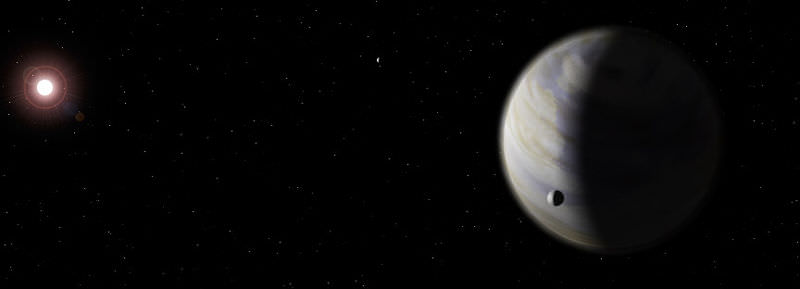
[/caption]
The first targeted SETI search of a system with a potentially habitable world has come up empty, but perhaps finding signals wasn’t the main objective in this search. Back in 2007 a group of astronomers used the Australian Long Baseline Array to listen for radio signals from Gliese 581, a red dwarf star that is now known to host at least six planets, with one in the star’s habitable zone. This was a SETI-type search for extraterrestrial-made signals, and it initially found 222 candidate signals. However, the team was able to reject all of them using automated analysis techniques, determining they were caused by Earth orbiting satellites. So why is this potentially good news?
This search was actually a proof of concept for using the Very Long Baseline Interferometry (VLBI) for targeted SETI searches, and that it worked well is great news for future searches that look specifically at a particular star system. Until recently most SETI searches were wide sky surveys, scanning wide, random areas of space looking for radio signals. But now, with the success of the exoplanet hunting Kepler mission, we now know of some potentially habitable systems and planets, and astronomers can do targeted searches, looking at specific spots in the sky.
It wasn’t known if the VLBI technique would be successful for such a “directed” targeted search, but this search by Hayden Rampadarath and team from the International Centre for Radio Astronomy Research at Curtin University in Australia proves it does.
The Australian Long Baseline Array is a combination of three radio antennae: the 22-meter Mopra Telescope, Parkes Observatory and the Australia Telescope Compact Array (ATCA) which are each a few hundred kilometers apart from each other. The data from the three locations are combined, making them act as one huge radio telescope, with an extraordinary angular resolution in the milli-arcsecond regime, the highest resolution in astronomy. And it turns out that VLBI techniques are great for SETI searches because they automatically exclude many Earth-based sources of interference that might otherwise look like SETI signals. That’s because the same signals have to show up at all the telescopes several hundred kilometers apart.
The team pointed the telescopes at Gliese 581 (Gl581), located 20 light-years distant in the constellation Libra for about 8 hours, tuning into frequencies close to 1500 megahertz.
The team said that the array would have been able to pick up a broadcast with a power output of at least 7 megaWatts per hertz, which means that if Gliese inhabitants had been broadcasting directly to Earth using an 300-meter Arecibo-style dish, the signals would have easily been picked up. However, ordinary radio transmissions, such as the ones Earthlings regularly transmit into space, would have been too weak to be detected.
But this bodes well for using other more powerful VLBI arrays such as the European VLBI Network, current most-sensitive VLBI array in the world or the upcoming Square Kilometre Array, which will have the sensitivity to pick up broadcasts of a few kilowatts per Hertz from 20 light years away.
So while this doesn’t mean that there is no life in the Gliese 581 system, this does mean we now have an expanded arsenal of tools for looking.
Source: Technology Review Blog
Aliens Don’t Want To Eat Us, Says Former SETI Director
[/caption]
Alien life probably isn’t interested in having us for dinner, enslaving us or laying eggs in our bellies, according to a recent statement by former SETI director Jill Tarter.
(Of course, Hollywood would rather have us think otherwise.)
In a press release announcing the Institute’s science and sci-fi SETIcon event, taking place June 22 – 24 in Santa Clara, CA, Tarter — who was the inspiration for Jodie Foster’s character in the film “Contact” — disagreed with both filmmakers and Stephen Hawking over the portrayal of extraterrestrials as monsters hungry for human flesh.
“Often the aliens of science fiction say more about us than they do about themselves,” Tarter said. “While Sir Stephen Hawking warned that alien life might try to conquer or colonize Earth, I respectfully disagree. If aliens were able to visit Earth that would mean they would have technological capabilities sophisticated enough not to need slaves, food, or other planets. If aliens were to come here it would be simply to explore.
“Considering the age of the universe, we probably wouldn’t be their first extraterrestrial encounter, either. We should look at movies like ‘Men in Black III,’ ‘Prometheus’ and ‘Battleship’ as great entertainment and metaphors for our own fears, but we should not consider them harbingers of alien visitation.”

Tarter, 68, recently announced her stepping down as director of SETI in order to focus on funding for the Institute, which is currently running only on private donations. Funding SETI, according to Tarter, is investing in humanity’s future.
“Think about it. If we detect a signal, we could learn about their past (because of the time their signal took to reach us) and the possibility of our future. Successful detection means that, on average, technologies last for a long time. Understanding that it is possible to find solutions to our terrestrial problems and to become a very old civilization, because someone else has managed to do just that, is hugely important! Knowing that there can be a future may motivate us to achieve it.”
On the other hand, concern that searching the sky for signs of life — as well as sending out your own — could call down hungry alien monsters would make a good case for keeping quiet. And a quiet search may not get the necessary funding to keep going. I can see where Tarter is coming from.
Let’s just hope she’s right. (About the eating part, at least.)
Top image: Alien 3, © 20th Century Fox. Tip of the tinfoil hat to EarthSky.org.
Alien Hunter Jill Tarter Changing Her Focus
[/caption]
After thirty-five years of listening for extra-terrestrial intelligence, astronomer Jill Tarter is stepping down from the research and will now be doing a more Earthly task: making sure there’s enough money for SETI to continue its search.
Tarter, who was the inspiration for the character Ellie Arroway in Carl Sagan’s novel and film “Contact,” announced today that Dr. Gerry Harp will step into the directorship role at SETI, “to continue our strong tradition of excellent research, freeing me up to focus on finding stable funding for it. I want to make the endowment of SETI research a success, so that my colleagues now, and in the future, can focus on the search for extraterrestrial intelligence for all of us.”
Tarter, 68, signed on to the NASA SETI program in the 1970s when a small group of NASA researchers were developing novel equipment and strategies to make systematic radio SETI observations. Since the decision by Congressional in 1993 to no longer fund the program, she has led the efforts at the non-profit SETI Institute to continue the work. Tarter spearheaded a decade-long program, dubbed Project Phoenix, that used large antennas in Australia, Puerto Rico and West Virginia to examine approximately one thousand nearby star systems over an unprecedented wide range of radio frequencies. Astronomers suspected that planets existed around other stars, but that was only a hypothesis – until 1995. Recently NASA’s Kepler telescope, launched in 2009, has discovered thousands of new planetary systems, some of them containing planets as small as the Earth.
“Kepler has been a paradigm shift—starting with the first data release in 2010 and second in 2011 and third in 2012, we have altered our SETI search strategy. We are no longer pointing our telescopes at Sun-like stars in hopes of finding something; we are now observing stars where we KNOW there are planets. Exoplanets are real. We’ve gone from having 20-30 potential targets to having thousands of targets. Kepler is telling us WHERE to look, and we are focusing there,” said Tarter.
SETI research is now only funded by private donations, “limiting how quickly we can search these newly discovered planets for intelligent life,” said Tarter. “The best reason to support SETI research is because it is an investment in our own future. The scientist Phil Morrison said that ‘SETI is the archeology of the future.’ Think about it. If we detect a signal, we could learn about THEIR past (because of the time their signal took to reach us) and the possibility of OUR future. Successful detection means that, on average, technologies last for a long time. That’s the only way another technological civilization can overlap with us in time and space. Understanding that it is possible to find solutions to our terrestrial problems and to become a very old civilization, because someone else has managed to do just that, is hugely important! Knowing that there can be a future may motivate us to achieve it.”
Tarter will be both celebrated and be one of the featured speakers at the gala dinner during the SETI Institute’s public event, SETIcon II, to be held at the Santa Clara Hyatt Hotel on June 22 – 24. See here for information on how to attend.
To give a donation to SETI, see their website.

